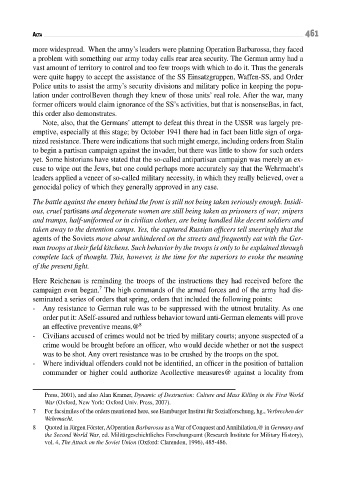Page 461 - Conflitti Militari e Popolazioni Civili - Tomo I
P. 461
461
aCta
more widespread. When the army’s leaders were planning Operation Barbarossa, they faced
a problem with something our army today calls rear area security. The German army had a
vast amount of territory to control and too few troops with which to do it. Thus the generals
were quite happy to accept the assistance of the SS Einsatzgruppen, Waffen-SS, and Order
Police units to assist the army’s security divisions and military police in keeping the popu-
lation under controlBeven though they knew of those units’ real role. After the war, many
former officers would claim ignorance of the SS’s activities, but that is nonsenseBas, in fact,
this order also demonstrates.
Note, also, that the Germans’ attempt to defeat this threat in the USSR was largely pre-
emptive, especially at this stage; by October 1941 there had in fact been little sign of orga-
nized resistance. There were indications that such might emerge, including orders from Stalin
to begin a partisan campaign against the invader, but there was little to show for such orders
yet. Some historians have stated that the so-called antipartisan campaign was merely an ex-
cuse to wipe out the Jews, but one could perhaps more accurately say that the Wehrmacht’s
leaders applied a veneer of so-called military necessity, in which they really believed, over a
genocidal policy of which they generally approved in any case.
The battle against the enemy behind the front is still not being taken seriously enough. Insidi-
ous, cruel partisans and degenerate women are still being taken as prisoners of war; snipers
and tramps, half-uniformed or in civilian clothes, are being handled like decent soldiers and
taken away to the detention camps. Yes, the captured Russian officers tell sneeringly that the
agents of the Soviets move about unhindered on the streets and frequently eat with the Ger-
man troops at their field kitchens. Such behavior by the troops is only to be explained through
complete lack of thought. This, however, is the time for the superiors to evoke the meaning
of the present fight.
Here Reichenau is reminding the troops of the instructions they had received before the
7
campaign even began. The high commands of the armed forces and of the army had dis-
seminated a series of orders that spring, orders that included the following points:
- Any resistance to German rule was to be suppressed with the utmost brutality. As one
order put it: ASelf-assured and ruthless behavior toward anti-German elements will prove
an effective preventive means.@ 8
- Civilians accused of crimes would not be tried by military courts; anyone suspected of a
crime would be brought before an officer, who would decide whether or not the suspect
was to be shot. Any overt resistance was to be crushed by the troops on the spot.
- Where individual offenders could not be identified, an officer in the position of battalion
commander or higher could authorize Acollective measures@ against a locality from
Press, 2001), and also Alan Kramer, Dynamic of Destruction: Culture and Mass Killing in the First World
War (Oxford, New York: Oxford Univ. Press, 2007).
7 For facsimiles of the orders mentioned here, see Hamburger Institut für Sozialforschung, hg., Verbrechen der
Wehrmacht.
8 Quoted in Jürgen Förster, AOperation Barbarossa as a War of Conquest and Annihilation,@ in Germany and
the Second World War, ed. Militärgeschichtliches Forschungsamt (Research Institute for Military History),
vol. 4, The Attack on the Soviet Union (Oxford: Clarendon, 1996), 485-486.

